Religious institutions often have a long and detailed history which is reflected in the fascinating artwork, documents and items which have accumulated over time. A clear example of this is in religious education, in which the ambience of the school is reflective of the history and devotion which is practiced there.
 Above: a detail from a painting of the Virgin Mary half way through a varnish removal by our conservators
Above: a detail from a painting of the Virgin Mary half way through a varnish removal by our conservators
Catholic schools in particular have an emphasis on artworks as a central part of their faith. Depictions of biblical scenes, many saints and most importantly the Virgin Mary playing a key role in daily worship, visual education and the creation of a devout ambience of the school which will be experienced by the students, staff, visitors and prospective parents.
 Above: details from an oil painting restoration featuring Saint Michael (part way through varnish removal)
Above: details from an oil painting restoration featuring Saint Michael (part way through varnish removal)
The preservation of such collections will often require specialist care, beyond the realm of routine maintenance. Antique and contemporary artworks, whether they are paintings, works on paper, or sculptures, may survive for hundreds of years, but during this time they may slowly begin to deteriorate or face a multitude of changing environments and risks. Even the most careful handling of an artwork may not prevent inherent decay of what is a historic object facing decades of change, requiring the intervention of a trained conservator with expertise.
In this article, we will offer guidance on the care of precious items, as well as a case study on the full restoration of a beautiful Mater Admirabilis from Woldingham School in Surrey.
 Above: an oil painting before and after restoration by our conservators including a surface clean and tear/puncture repairs
Above: an oil painting before and after restoration by our conservators including a surface clean and tear/puncture repairs
Caring for Catholic school collections
When faced with a school collection you may be presented with a multitude of materials, from wooden furniture and textiles, to oil paintings and hand-written scripture. All of these precious objects will have specific needs in terms of environment and atmosphere, the control of which will help to prevent any increased risk of decay.
Specifically, higher risks face artworks in churches and chapels, including:
- Soot and smoke from candles building up on the surface of an artwork over time.
- A contrast in temperatures may be hard to control in historic buildings, resulting in a dangerously fluctuating environment which causes materials to expand and contract.
- Levels of humidity or poor insulation due to old architecture, affecting porous materials such as paper, wood, panels and textiles.
- Frequent handling of specific items which may deteriorate over time without intervention.
 Above: the interior of a church featuring a sculpture of Virgin Mary and various artworks from different eras
Above: the interior of a church featuring a sculpture of Virgin Mary and various artworks from different eras
We recommend that on a regular basis the pieces on display have a routine inspection. This can be a simple chart which logs details of their condition and their surroundings. For example, a measurement should be taken of the temperature and relative humidity to ensure they have not gone beyond the recommended limits. With some materials this is extremely important, for example a work on paper may face fading from too much sunlight exposure or have a development of mould and foxing from moisture in the air.
If you would like a full booklet on the treatment and care of artwork and specialist items in your school’s inventory, please get in touch with our team who will be happy to provide you with further literature on the subject and answer any questions you may have. You can email [email protected] or call us on 0207 112 7576
The history and symbolism of Mater Admirabilis
The beautiful Mater Admirabilis or ‘Mother Most Admirable’ has a fascinating history which has become a central part of Sacred Heart education and Catholic devotion.
 Above: various depictions of Mater Admirabilis on different types of media, including metal, oil painting, paper and sculpture
Above: various depictions of Mater Admirabilis on different types of media, including metal, oil painting, paper and sculpture
Originally painted as a fresco in 1844, the artist was a young French girl called Pauline Perdreau. The artwork is an excellent study in perspective, bringing the Virgin Mary to the forefront of the piece within a grand hall, the tiles expertly sizing backwards towards a landscape to create a true dimension to the wall painting which would have given depth and realism to the viewer. The Virgin is located in a typical setting which is reflective of a heavenly portico above the world.
 Above: the location of Mater Admirabilis at Trinità dei Monti in Rome (left), the original fresco (centre) and a detail of the signature (right)
Above: the location of Mater Admirabilis at Trinità dei Monti in Rome (left), the original fresco (centre) and a detail of the signature (right)
We can see further artistic symbolism featured in the painting, carefully selected by Pauline; these are all used to enhance specific virtues of the Virgin Mary. Firstly, the unusual spindle in her hand and wooden distaff beside her represent a dedication to hard work, a rejection of idleness and an appreciation of craftsmanship. The Virgin sits in reflection of her labour, contemplating both her task and the open scripture which is left in the basket below. On her left, a lily in a vase is a classical sign of purity. The fresco, as well as the Woldingham School reproduction of the artwork, feature a three-dimensional halo of stars. There are in particular 12 stars, an important symbolic number in Christian faith.
 Above: examples of the use of ultramarine (blue) in famous paintings, including artworks by Raphael (left), Bellini (centre) and Elisabetta Sirani (right)
Above: examples of the use of ultramarine (blue) in famous paintings, including artworks by Raphael (left), Bellini (centre) and Elisabetta Sirani (right)
Unusually, Pauline’s depiction of the Virgin Mary used a bright pink tone, in contrast to the usual blue robes made famous in the renaissance period through the use of an expensive and dazzling pigment called ultramarine. As well as being symbolic of the Virgin’s virtues, ultramarine was often decided by the patron, rather than the artist themselves, as it had an association with wealth due to its price and therefore seemingly heightened their devotion through monetary contribution. Pauline’s Virgin Mary, by contrast, is a purely creative effort which is free of any input from patrons, wealth, or those around her. The young girl chose her own palette and symbolism, perfecting her own vision of the mother of Christ. It is also rumoured that she had a favourite pink dress, which the Nuns had forbidden her to wear at the time.
 Above: a Virgin Mary and Child painting which was recently restored by our team, before and after treatments
Above: a Virgin Mary and Child painting which was recently restored by our team, before and after treatments
Due to Pauline’s rebellious choice of colour, the fresco was seen to be inappropriate by the Nuns which had commissioned it at the Trinità dei Monti church in Rome. It was covered up for many years behind a drape. Later, the Pope visited the Church and came across this covered area. He requested to see what was hidden and the fresco was unveiled, over time the colours had faded and the painting had a soft and delicate appearance. The Pope declared that this was “Mater Admirabilis!” (mother most admirable) and that she should never be covered up again. In the following years many miracles were attributed to the painting and to this day she is on public display in Rome. The Pope rediscovered the painting on 20th October, which went on to be the feast day for Mater Admirabilis and is observed by the society of the Sacred Heart.
Mater Admirabilis restoration
In 2020 our team were contacted by Woldingham School in Surrey about their easel painting reproduction of Mater Admirabilis. As a Sacred Heart school, this painting is an important part of worship and devotion for their students. We arranged that the restoration would take place during the summer holiday and ensure it was returned in time for the new school year.
 Above: the painting half way through varnish removal (left, centre) and a close up of a small tear and discolouration (right)
Above: the painting half way through varnish removal (left, centre) and a close up of a small tear and discolouration (right)
Our conservators assessed the painting, finding areas of flaking and unstable paint. The historic varnish had also discoloured over time, placing an unintentional veil over the painting which detracts from its symbolic and religious importance as a painting which should never be hidden from perfect view.
Above: a video of our conservators assessing the painting, cleaning the surface, and cleaning the three-dimensional stars
A surface clean and varnish removal was the first treatment performed by our trained team, this allowed the original tones of the painting to come back to life. The pink dress and bright blue skies were significantly brighter and could now be protected with a new layer of non-yellowing, conservation grade varnish.
 Above: before our team consolidated and retouched the painting (left), our conservator retouching pigments (centre) and the finished retouching of the foot and vase area (right)
Above: before our team consolidated and retouched the painting (left), our conservator retouching pigments (centre) and the finished retouching of the foot and vase area (right)
The three-dimensional stars were also cleaned, taking away any surface contamination which may have built up over time. In churches and chapels, the smoke from candles may be a factor in the discolouration of artwork and other materials, as this small amount of fire exposure may be a frequent occurrence over many decades and without professional intervention it may slowly distort the original impact of the artwork.
Above: our conservators consolidating the paint layer with specialist techniques and retouching missing areas of paint
Areas of flaking paint were carefully consolidated using a heat treatment which presses them into place and through injections of a solution that adheres them to the canvas. This means that the rest of the painting is now at lowered risk of deterioration growing from these gaps in the paint layer. These spaces were then filled to create an even surface, before being retouched with conservation-grade pigments which are expertly colour-matched with the original.
 Above: our conservator cleaning the stars on the painting with a tailored solvent solution
Above: our conservator cleaning the stars on the painting with a tailored solvent solution
All aspects of conservation are reversible, this means that in decades or centuries time the work of our conservators will never be confused with the original artwork and can be easily replaced if new damage occurs in the future.
The finished restoration allowed this wonderful Mater Admirabilis to be returned to her devoted students at Woldingham for a new school year in 2021. She is now free of risk of continued deterioration and has had her visual impact returned through the restored colours of the original composition.
 Above: the before and after images from the restoration of Woldingham School’s Mater Admirabilis
Above: the before and after images from the restoration of Woldingham School’s Mater Admirabilis
Get in touch with our team
If you have an artwork or item in your care which may be in need of treatment or cleaning by our skilled team of conservators, please get in touch to discuss how we can help you achieve this restoration.
Please contact us via email [email protected] or call 0207 112 7576

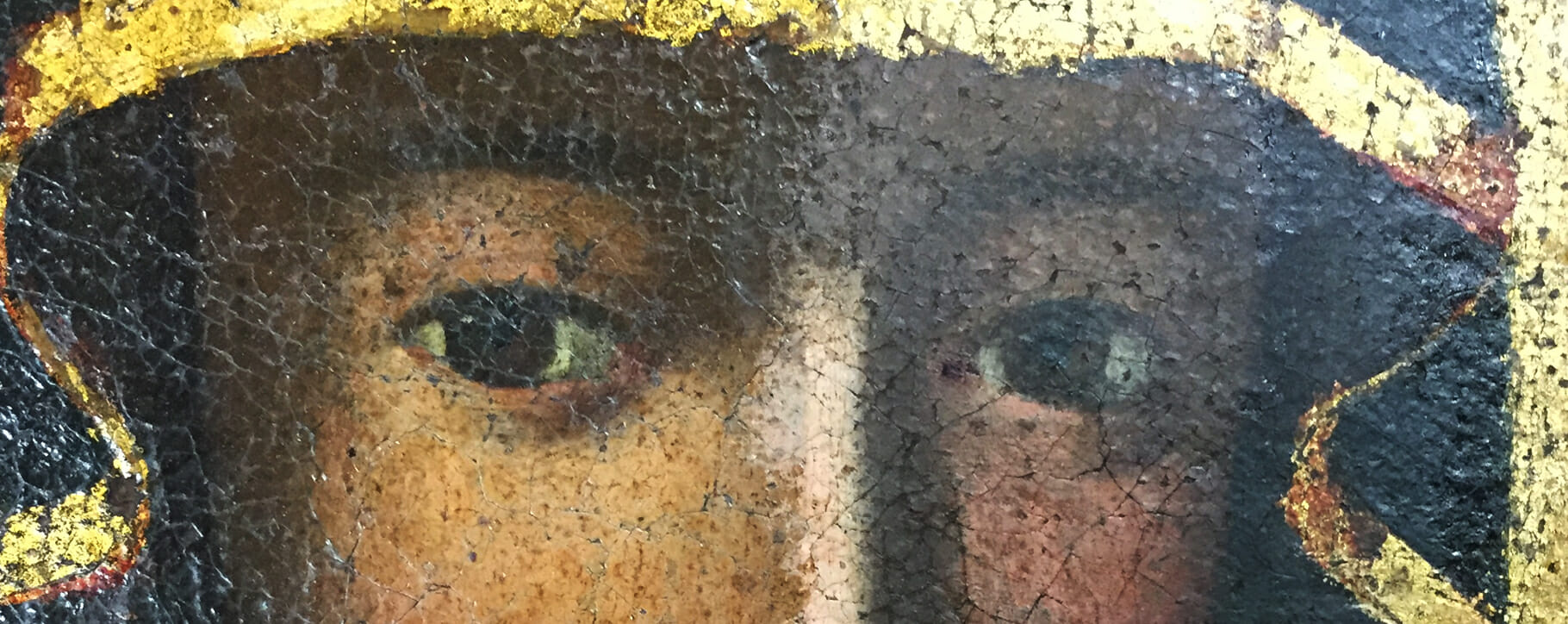 Above: a detail from a painting of the Virgin Mary half way through a varnish removal by our conservators
Above: a detail from a painting of the Virgin Mary half way through a varnish removal by our conservators Above: details from an oil painting restoration featuring Saint Michael (part way through varnish removal)
Above: details from an oil painting restoration featuring Saint Michael (part way through varnish removal)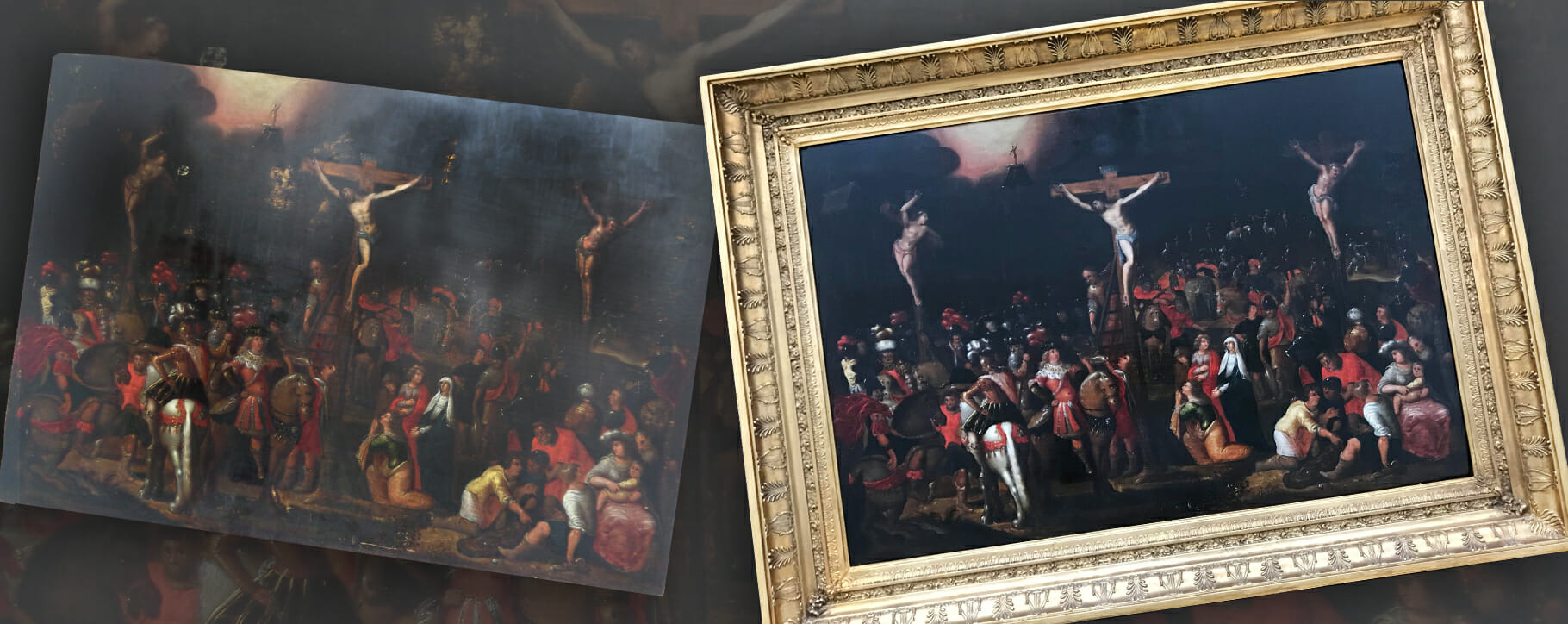 Above: an oil painting before and after restoration by our conservators including a surface clean and tear/puncture repairs
Above: an oil painting before and after restoration by our conservators including a surface clean and tear/puncture repairs Above: the interior of a church featuring a sculpture of Virgin Mary and various artworks from different eras
Above: the interior of a church featuring a sculpture of Virgin Mary and various artworks from different eras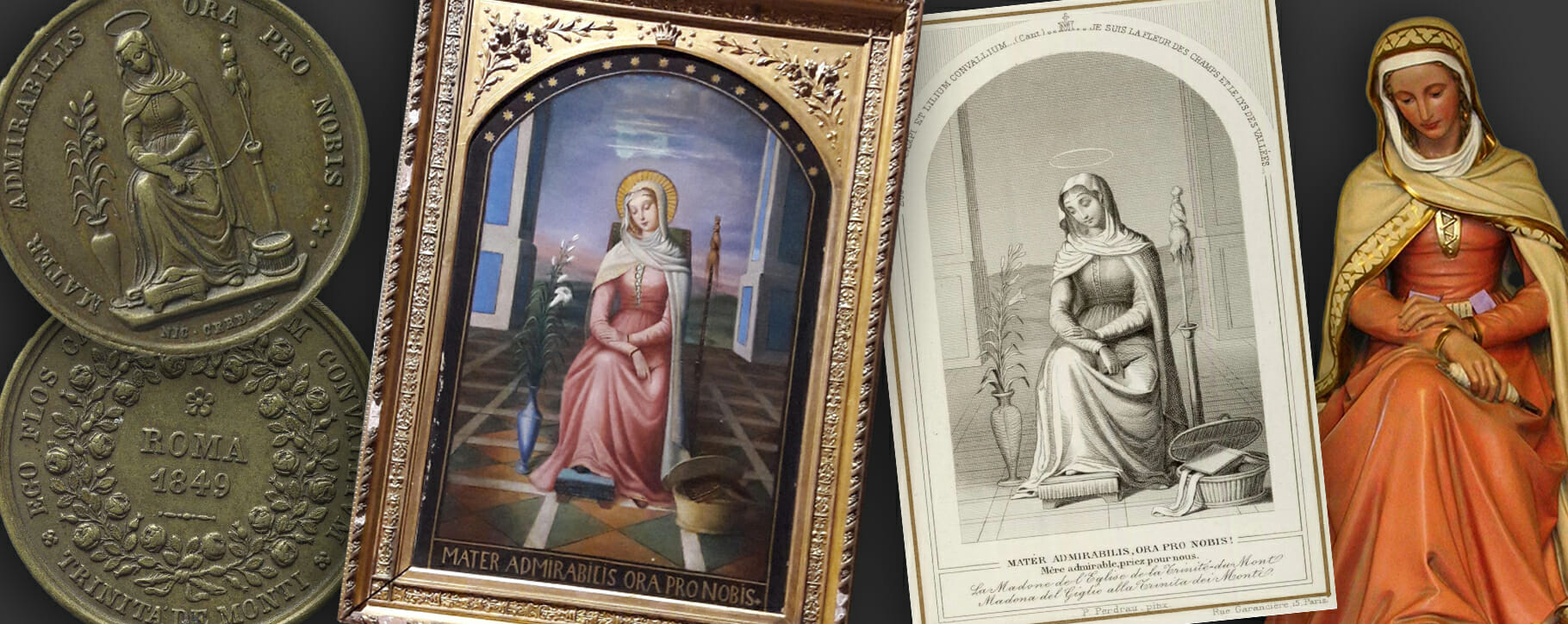 Above: various depictions of Mater Admirabilis on different types of media, including metal, oil painting, paper and sculpture
Above: various depictions of Mater Admirabilis on different types of media, including metal, oil painting, paper and sculpture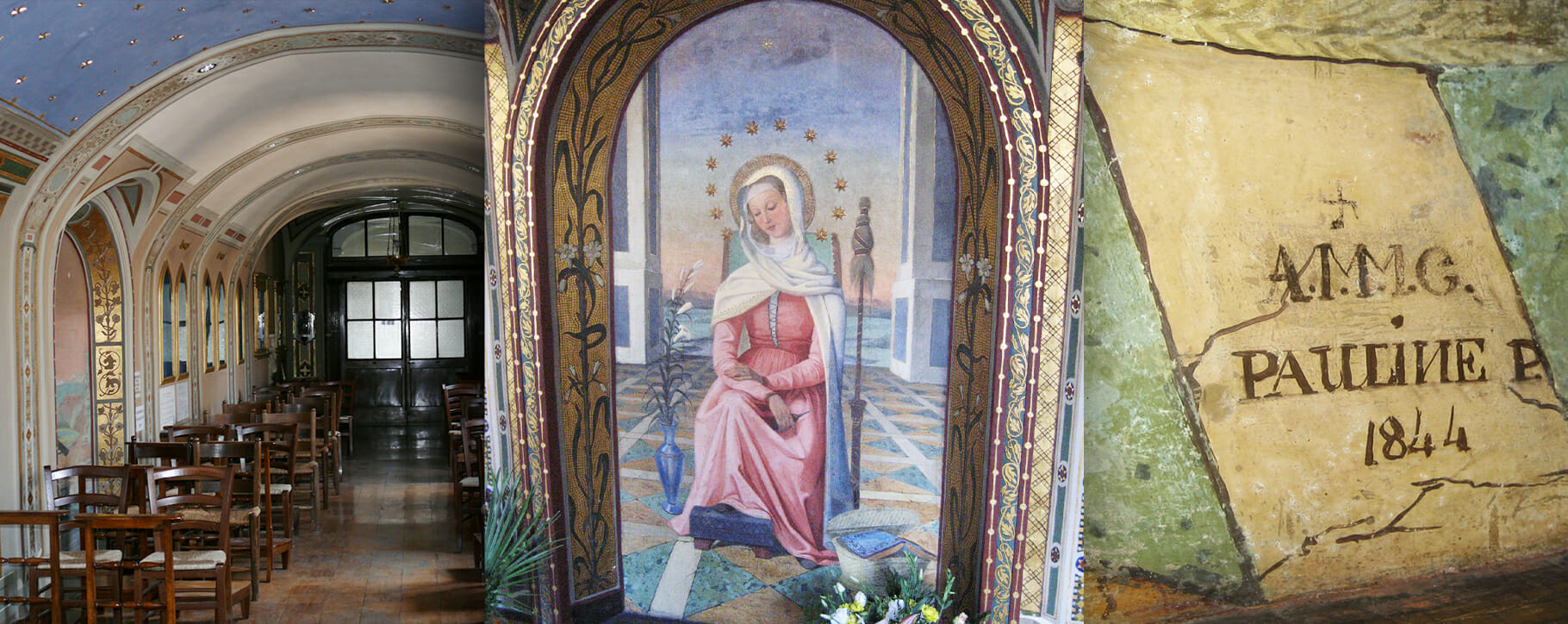 Above: the location of Mater Admirabilis at Trinità dei Monti in Rome (left), the original fresco (centre) and a detail of the signature (right)
Above: the location of Mater Admirabilis at Trinità dei Monti in Rome (left), the original fresco (centre) and a detail of the signature (right) 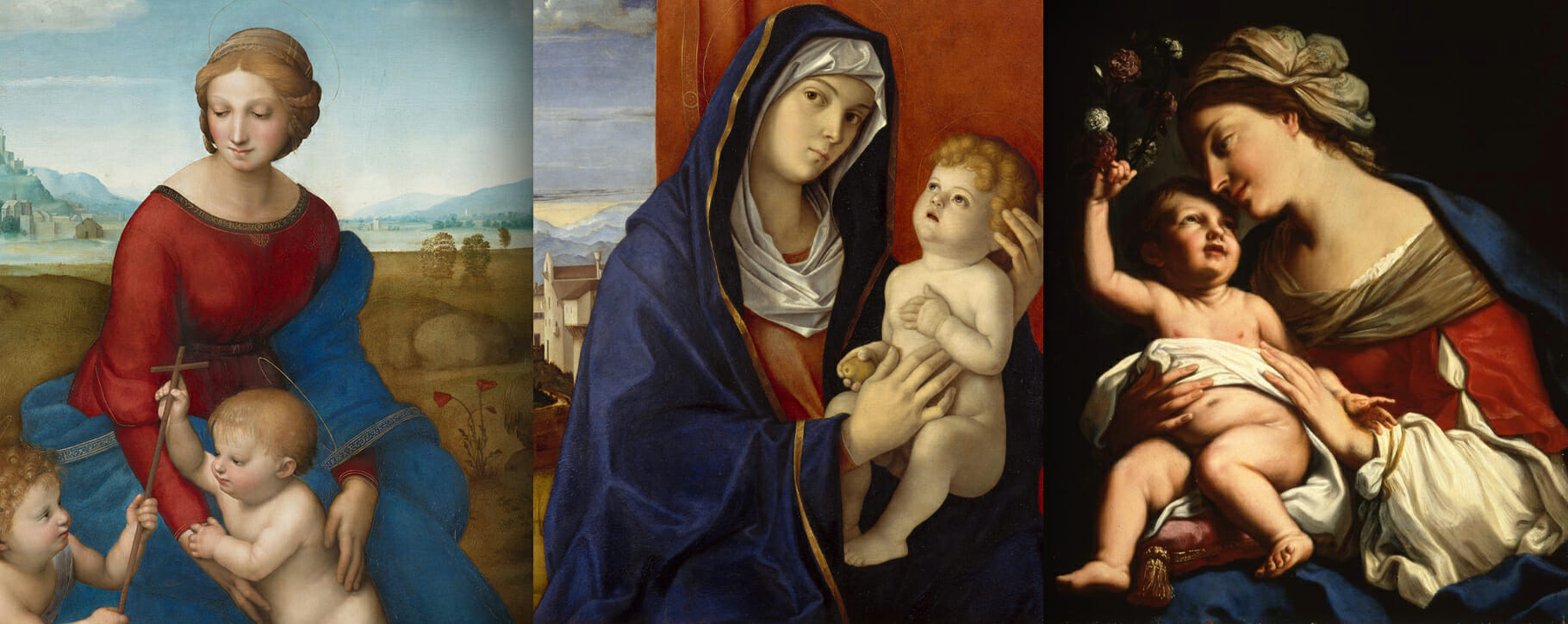 Above: examples of the use of ultramarine (blue) in famous paintings, including artworks by Raphael (left), Bellini (centre) and Elisabetta Sirani (right)
Above: examples of the use of ultramarine (blue) in famous paintings, including artworks by Raphael (left), Bellini (centre) and Elisabetta Sirani (right) Above: a Virgin Mary and Child painting which was recently restored by our team, before and after treatments
Above: a Virgin Mary and Child painting which was recently restored by our team, before and after treatments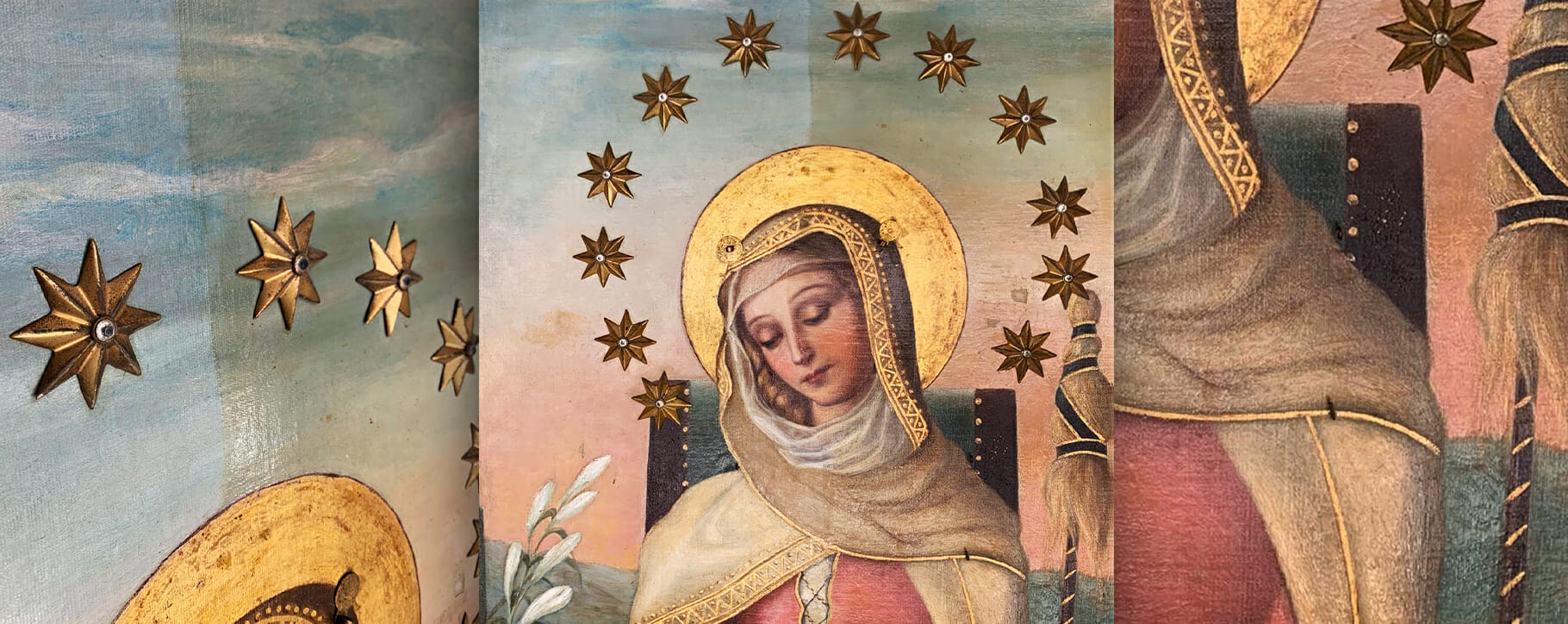 Above: the painting half way through varnish removal (left, centre) and a close up of a small tear and discolouration (right)
Above: the painting half way through varnish removal (left, centre) and a close up of a small tear and discolouration (right)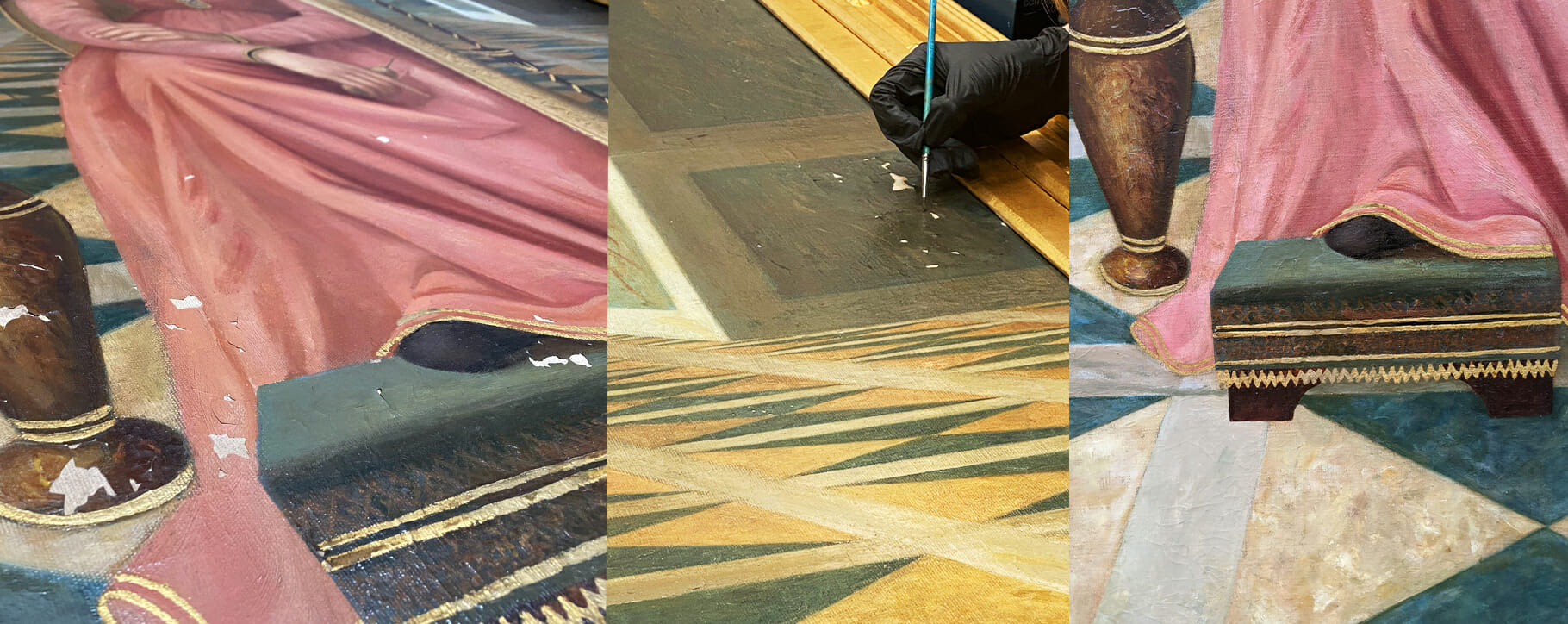 Above: before our team consolidated and retouched the painting (left), our conservator retouching pigments (centre) and the finished retouching of the foot and vase area (right)
Above: before our team consolidated and retouched the painting (left), our conservator retouching pigments (centre) and the finished retouching of the foot and vase area (right)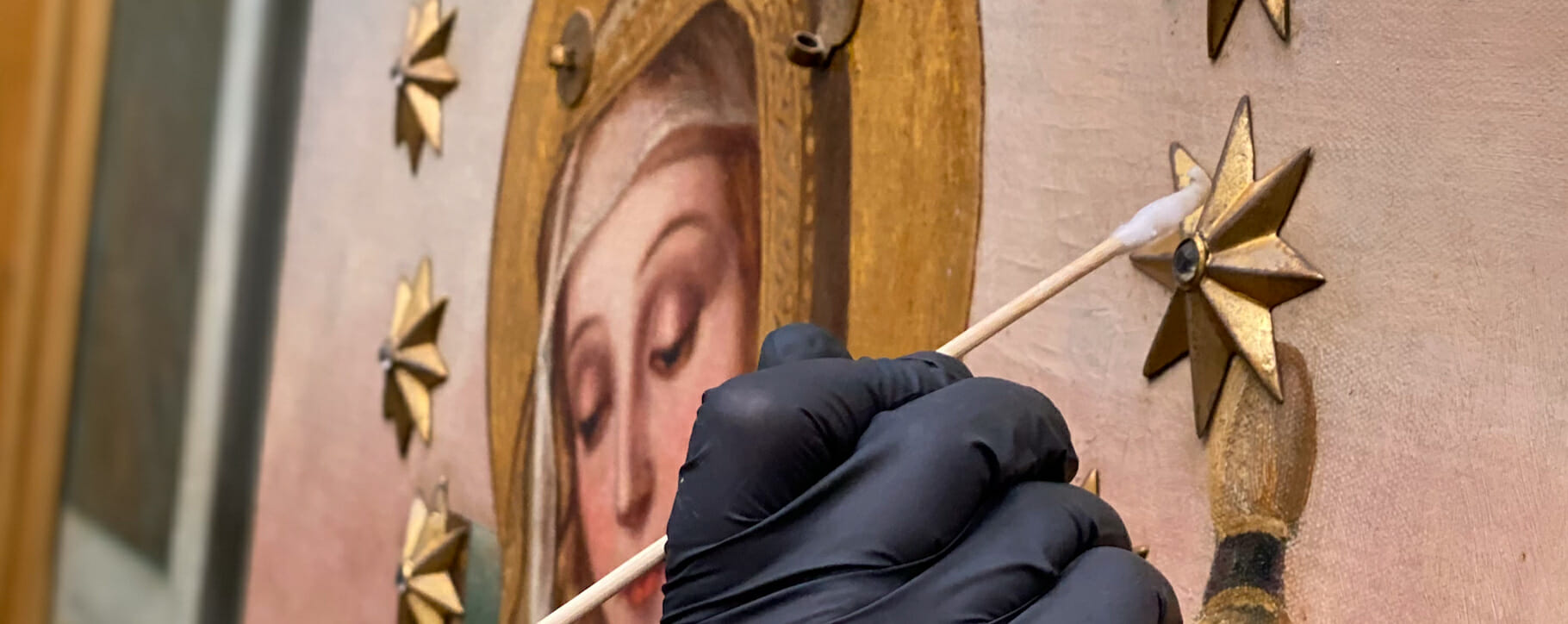 Above: our conservator cleaning the stars on the painting with a tailored solvent solution
Above: our conservator cleaning the stars on the painting with a tailored solvent solution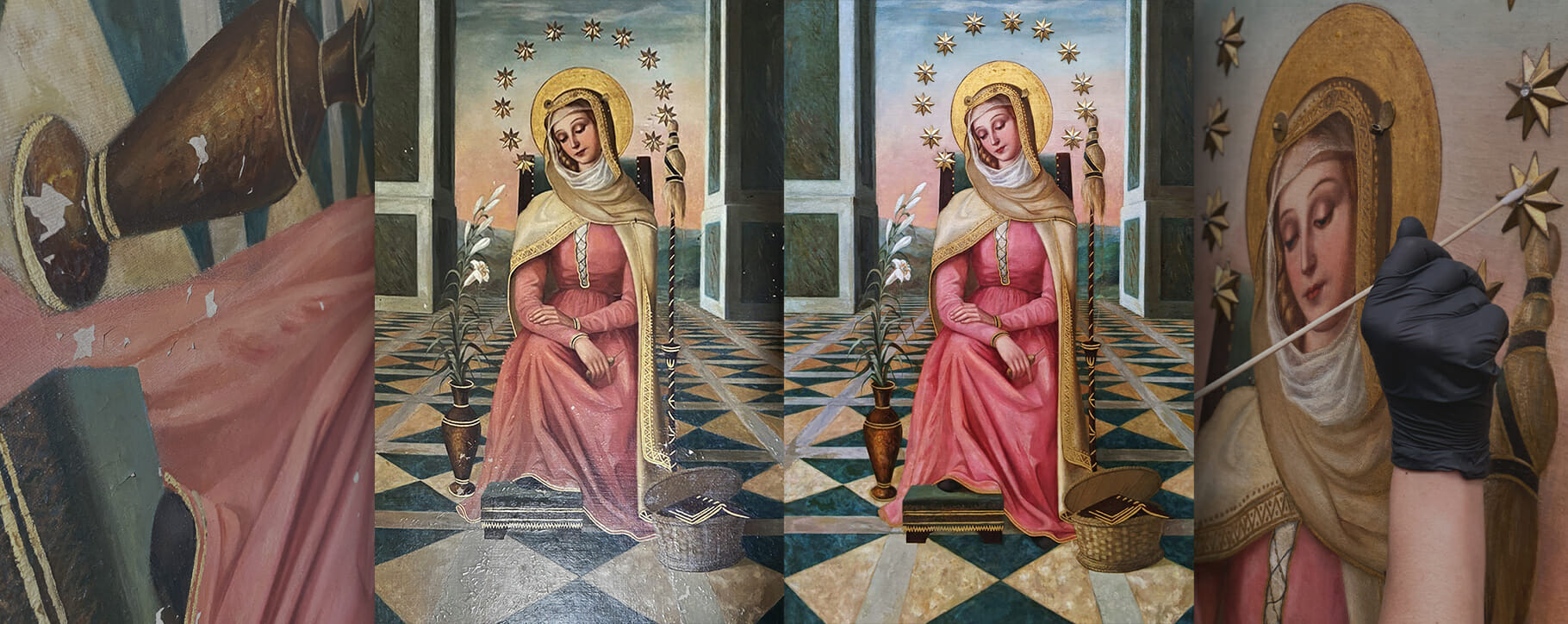 Above: the before and after images from the restoration of Woldingham School’s Mater Admirabilis
Above: the before and after images from the restoration of Woldingham School’s Mater Admirabilis




